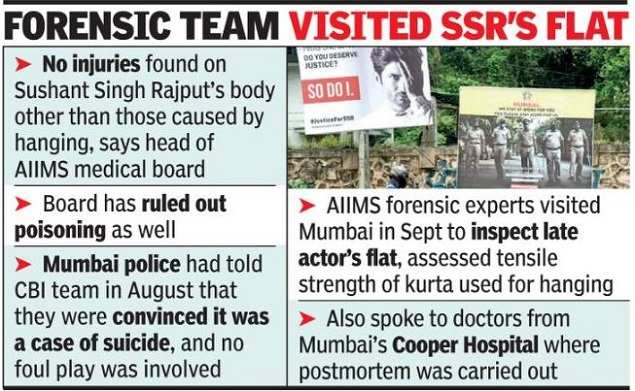“It is a case of hanging and death by suicide,” Dr Sudhir Gupta, chairperson of the medical board constituted to find out the manner and cause of death of Rajput, told TOI. The actor had been found hanging in his apartment in Mumbai on June 14.
“There were no injuries on the late actor’s body other than the ones caused by hanging. We did not find any marks of struggle or scuffle on the body and clothes either,” said Dr Gupta.
Mumbai Police had, in fact, told the CBI team in August that they were convinced it was a case of suicide and that they had not detected any foul play. However, Rajput’s family lawyer, Vikas Singh, insisted as late as September 25 that it was a case of death by strangulation and that he was feeling “frustrated by the delay in the CBI taking a decision to convert abetment of suicide to murder”.
AIIMS conducted tests on the viscera (internal organs) samples of the deceased actor and ruled out poisoning as the cause of death. Dr Gupta, who is professor and head of the forensic medicine department at AIIMS, said there was no trace of any poison in it.
The Forensic Sciences Laboratory (FSL) in Mumbai had also conveyed the same to Mumbai Police when they were investigating the case initially.
Sources said the AIIMS team had a meeting with the CBI, which is investigating the case, to share its findings. However, it is not confirmed whether AIIMS has submitted its findings in the case in writing or not.

A team of forensic experts from AIIMS had visited Mumbai in September to inspect the late actor’s flat where he was found hanging. The AIIMS team had recreated the scene of the alleged suicide. The tensile strength of the ligature material — which was a kurta — was also assessed, sources said.
They also interviewed doctors from Cooper Hospital in Mumbai who had carried out a post-mortem on the 34-year-old to reach a conclusion since the family was saying that the actor may have been murdered. Later, the forensic unit that had conducted the post-mortem was called to the CBI guesthouse where the doctors were asked to explain how they had ruled out the possibility of ligature strangulation.
Sources in the medical board said it took more than a month to reach a conclusion on the cause and manner of death because videography of the post-mortem carried out at Cooper Hospital wasn’t available. “The hospital didn’t even have pictures of dissection of the body during autopsy,” said a source.
The source, however, added that the conclusion reached by the board was based on due diligence and analysis of all available evidence. “It is our final opinion. The job assigned to us in this case is over and should be treated as closed,” said one of the members.

